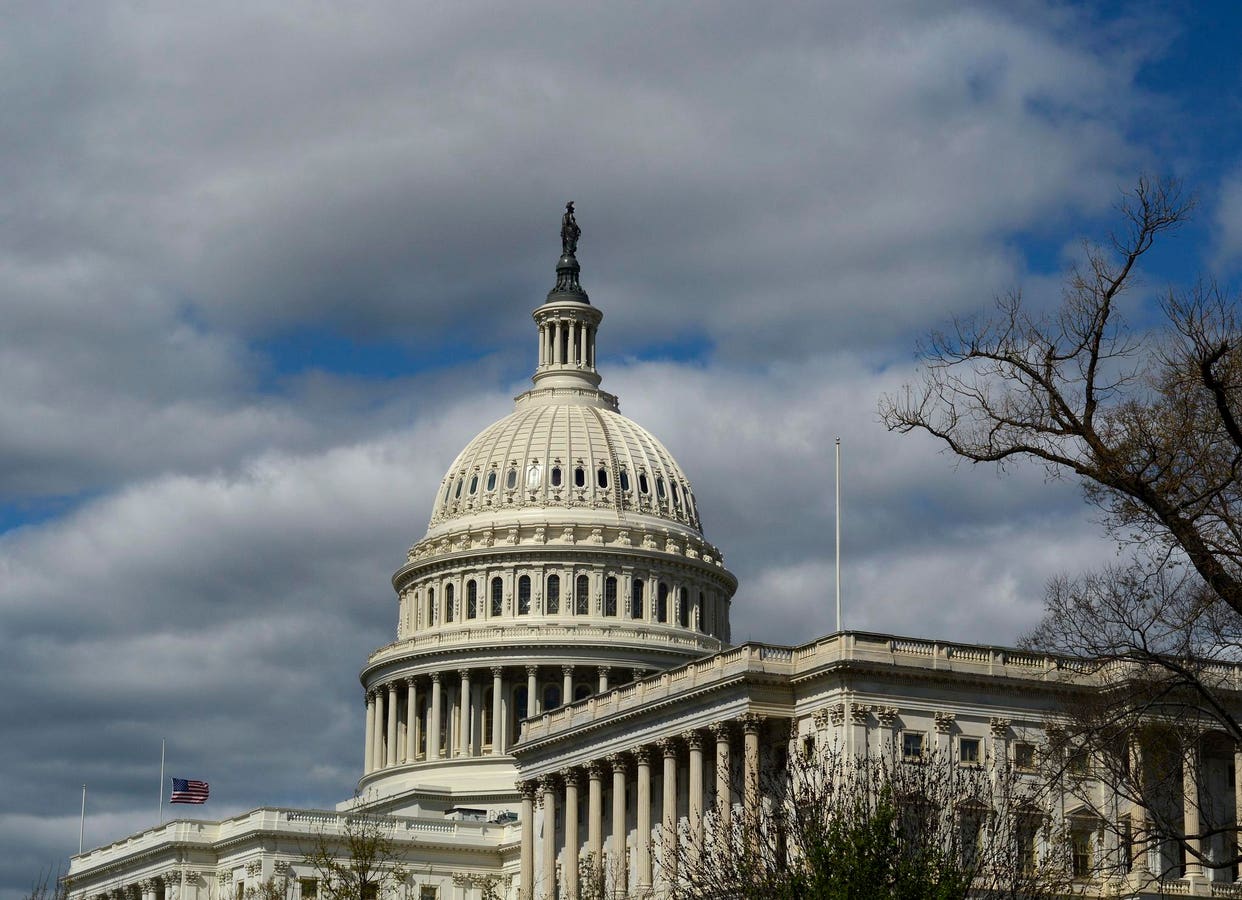The Capitol Building, home of the United State Congress.
Green Technologies At Risk In Current Mega Bill
As it was written, the Big, Beautiful Bill (Mega Bill) passed by The House of Representatives in May would handicap certain green projects (solar, wind, and batteries) that are in line to receive tax credits made available by the Biden government. The handicap is hard to understand because in the U.S. over 90% of new energy projects in 2023 and 2024 was generated by solar, wind, and batteries.
What is the handicap? The Mega Bill mandates that such projects must begin within two months of passage of the bill, and would have to be completed, and in service, by the last day of 2028, or the tax credits would be canceled.
To see what impact this would have on green projects, one analysis looked at clean electrical projects that are currently in the interconnection queue, and due to go online during 2028 or later (it wouldn’t be uncommon for projects slated to complete in 2028 to spill over to 2029, which would cancel the tax credits.)
The total for all these at-risk projects in Figure 1 amounts to 600 GW (gigawatts). The largest three projects are CAISO of California at 183 GW, ERCOT of Texas at 128 GW, and MISO (Midwest and South) at 111 GW.
Figure 1.
The truth is, current electrical production in U.S. is 1200 GW, and this will need to grow rapidly to power new AI data centers. So, if all these seven green projects lost their tax credits and dropped out of the interconnection queue, it would represent a huge loss that is 50% of current electrical production in the U.S. This loss would be like tossing away 600 traditional power plants that added up to 50% of current U.S. electricity supply.
Granted, a number of projects in Figure 1 would drop out of the queue anyway, due to other factors such as financial commitments that fall through. But still, a loss of remaining projects that would stand to boost current U.S. power by 30% or 40% or 50% would be an unforgiveable loss—especially since solar, wind and battery projects have all the market momentum in the past few years.
Speaking of momentum, in 2023 and 2024 in the U.S., the vast majority (93%–94%) of new energy sources were solar, wind, and batteries. The only commercially proven competitor is gas-fired power plants, which are facing serious delays, and they cost more.
What if projects that lost their tax credits were to go ahead to completion? They might, but it’s obvious this would translate to higher cost of electricity for consumers.
Mega Bill Changes Suggested By Senate.
The House Mega Bill has gone to the Senate, and on Monday June 16 they have proposed some changes.
UtilityDive reports that the harsh “start by – complete by” House requirement to access the tax credits has been removed. In one box, nuclear, geothermal and hydropower can claim the tax credits so long as they start construction by 2033.
But in another box, wind and solar can obtain only 60% of the tax credits and only if they break ground by 2026. Or 20% if by 2027. Or zero if after that. This is a serious handicap for the frontrunners, solar and wind, that have provided over 93% of new electrical capacity in 2023 and 2024. And it comes at a crucial time, because the U.S. needs to quickly boost its power capability by a massive amount to supply AI data centers.
One positive: battery storage or BESS (battery energy storage systems) can access tax credits until 2036, although the credits will be tapered down, according to Canary Media. Also, some solar and wind projects would be able to keep the tax credits beyond the end of 2028—provided they exist on federal land, generate 1 GW or more power, and have obtained right-of-way approval from the BLM (Bureau of Land Management).
The next steps are: the Senate as a whole has to pass these changes, and then attempt to reconcile with the House. The timeline is short as the goal is to get the final version of the Mega Bill to President Trump’s desk by July 4.
Coming out of all the discussion and debate, it seems the Mega Bill wants to handicap wind and solar and batteries. But why?
Reasons Why The Mega Bill Would Handicap Wind And Solar Energy.
First, the Bill will cause electricity prices to rise. If cheap wind, solar and batteries are handicapped in preference to expensive almost-defunct coal power plants, commercially unproven SMRs (small modular nuclear reactors), and next-gen geothermal methods, then prices of electricity will rise. Table 1 lays this out, using the most recent LCOE data from Lazard.
Table 1. Most recent LCOE estimates for various electrical sources.
With tax credits and based on a utility scale, solar PV + BESS and wind + BESS are cheaper than geothermal with tax credits, and much cheaper than gas-fired power, nuclear, and coal. If the Mega Bill handicaps wind and solar in the race, electrical costs will zoom upwards.
Second, the Bill seems to be unaware of green energy success in Australia. In the state of South Australia renewables plus batteries have been providing 72% of grid electricity continuously for three years, and this is expected to rise to 100% by 2027. Solar, wind, and batteries have proven the stability and reliability of renewables commercially.
The first grid-scale BESS was started in 2017 by Elon Musk in South Australia, and BESS are expanding rapidly in the U.S. as well as in Australia. Intermittent power is no longer a reason to dismiss renewables, despite what the Energy Secretary says, because BESS have solved this problem and electricity from solar and wind renewables with BESS is dispatchable.
Third, the Bill assumes new investments in old energy (coal, natural gas, and nuclear) will be embraced by the U.S. population. However, global spending on low-carbon power has doubled in the past five years. Solar PV is the leader in this space, with investments that will reach $450 billion in 2025.
Coal is too dirty when it burns, and in the U.S. the market share has dropped from 50% in 2011 to 11% in 2024. Natural gas burns cleaner than coal, but the market for new gas-fired power plants has dropped out in the past two years, due to cost and delays in permitting and supply chains.
The cost of new nuclear reactors, whether traditional reactors or SMRs, is substantially higher than renewable energies (Table 1). There is also the ubiquitous threat of being exposed to nuclear radiation, either from nuclear accidents or from underground storage of nuclear waste.
It has been reported that U.S. nuclear reactors that were decommissioned some time ago can be recommissioned, but at a heavy cost of around $1 billion per unit.
Fourth, the Bill enables China to forge ahead with a green energy economy, while the U.S. goes backward.
Energy from solar, wind, and batteries is cheap, and has a short new-build time. It will continue to provide jobs and grow the economy, and benefits include lower electricity prices and less pollution. A key advantage is already-commercialized power for data centers that will enable the U.S. to compete with China in the race for AI. The handicap and setbacks of a thriving clean industry in the U.S. would be China’s gain.
Fifth, the Bill will force job losses by handicapping green industries.
If projects in the above list of seven in Figure 1 were to be canceled due to the Mega Bill handicaps, there could be serious job losses. To illustrate by results in 2024, one report quotes $80 billion invested in clean power in 2024, which supported 1.4 million jobs in the U.S.
Another answer is that current tax credits would enable strong economic growth by 2035: almost $2 trillion of monetary growth and almost 14 million jobs. This amounts to a return on the federal investment by four-times.
The green energy benefits and financial returns of wind and solar with battery storage apply to both Republican and Democratic states in the U.S.. But so do the losses, if Congress decides to handicap wind and solar renewables.
The biggest losses may be soaring electricity costs in the U.S., and the U.S. bending to China’s clean energy boom of surging solar and BESS projects that will reliably service their AI data center programs.








